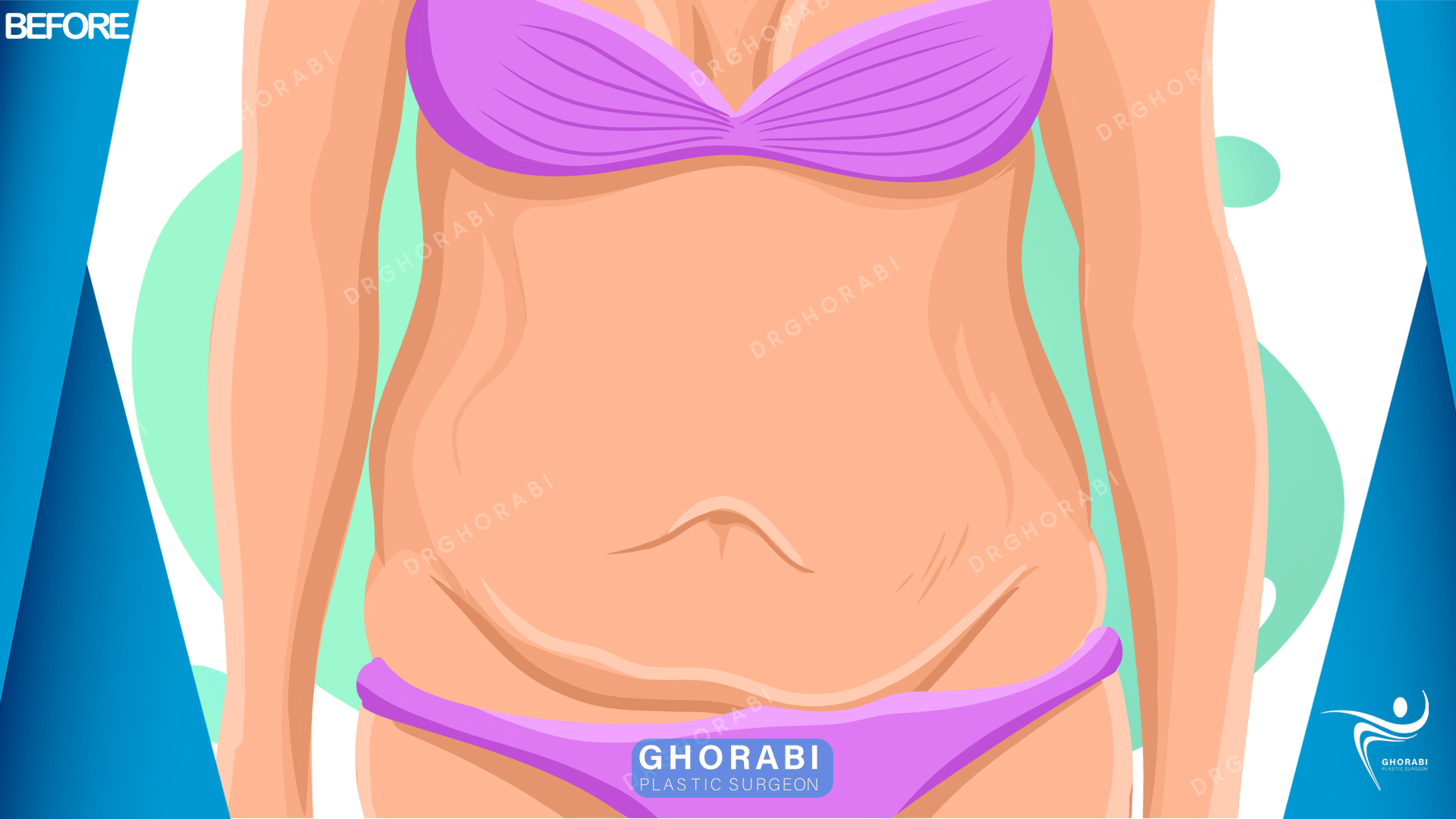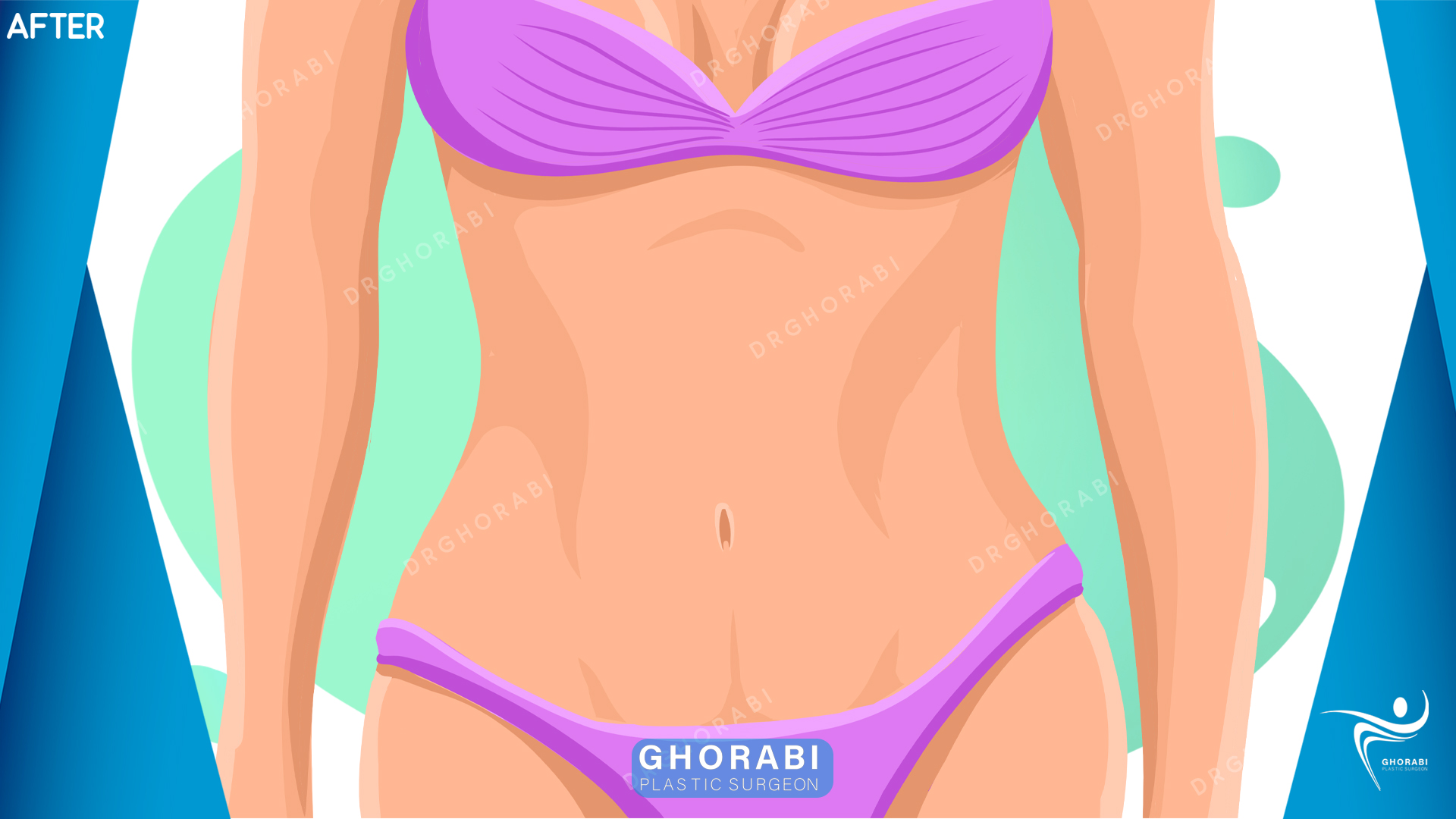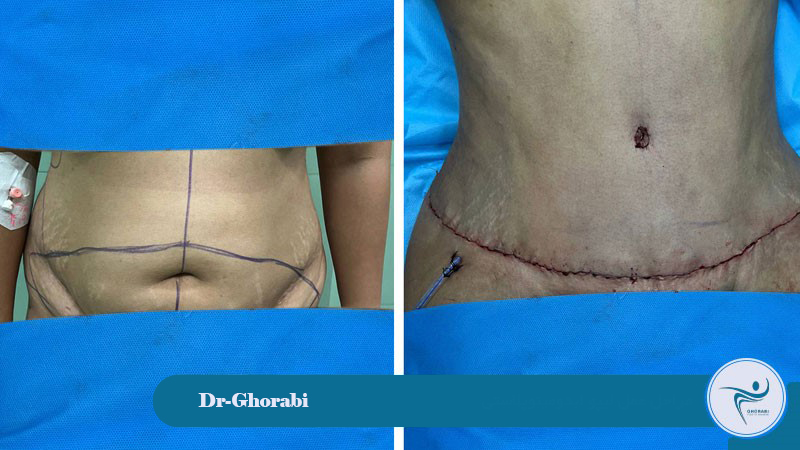Lipoabdominoplasty is a combined procedure of liposuction and abdominoplasty. In a lipoabdominoplasty, excess fats are first carefully removed from various body areas using liposuction. Then, abdominoplasty is performed to correct sagging and shape the abdominal area. The result of this process will be a flatter abdomen, a narrower waist, and a significant improvement in body contour.
Individuals who suffer from localized fat accumulation and sagging abdominal skin are considered suitable candidates for this procedure. The stages of this surgery are expert consultation, pre-operative preparations, performing the surgery, and undergoing the recovery period. Lipo and abdo surgery is considered an effective step for enhancing beauty and self-confidence.
Steps of the Lipo Abdo Procedure
Before abdominoplasty surgery, a consultation with a cosmetic surgeon will be held to assess your condition and determine the goals of the procedure. Medical tests and a medical history will be performed. You will be given specific instructions, such as avoiding smoking and certain medications, to prepare for the surgery. The steps of lipoabdominoplasty surgery include:
After abdominoplasty, expect pain, swelling, and bruising that will gradually subside. The use of a special compression garment and care of drains (if present) is essential. Regular appointments with the surgeon will be scheduled to monitor the recovery process and ensure complete healing.
Essential tests for liposuction and abdominoplasty surgery
Before undergoing lipomatic and lipoabdominoplasty, it is very important to undergo a series of necessary tests to ensure your health and readiness for surgery. These tests help the surgeon minimize potential risks and plan a safe and successful surgery. Below is a table of these necessary tests:
| Test Categories | Type of Test | Purpose |
| Blood Tests | Complete Blood Count (CBC) | Checking red blood cells, white blood cells, and platelets to diagnose anemia, infection, or blood disorders. |
| Blood Coagulation Test (PT/PTT) | Evaluating the blood’s ability to clot and diagnosing coagulation disorders that can increase the risk of bleeding or thrombosis. | |
| Basic Metabolic Panel (BMP) or Comprehensive Metabolic Panel (CMP) | Checking kidney and liver function, electrolyte levels, blood sugar, and proteins. These tests evaluate the body’s metabolic status and indicate any imbalances. | |
| Blood Type and Rh | Determining blood group and Rh factor for preparation for blood transfusion in case of emergency. | |
| Urine Tests | Urinalysis | Checking for urinary tract infections, diabetes, and kidney diseases. |
| Cardiac Tests | Electrocardiogram (ECG/EKG) | Evaluating heart rhythm and function, especially for patients over 40 years old or with a history of heart disease. |
| Echocardiography (if needed and diagnosed by a physician) | Evaluating heart structure and function, especially if there is a history of heart disease or abnormal findings on ECG. | |
| Imaging Tests (if needed and diagnosed by a physician) | Chest X-ray (CXR) | Checking lung and heart health, especially in smokers or individuals with a history of respiratory disease. |
| Other Tests (based on individual conditions and physician’s diagnosis) | Pregnancy Test (for women of childbearing age) | Ensuring no pregnancy before surgery, as surgery is dangerous for the fetus. |
| Other specialized tests based on the individual’s medical history, such as thyroid tests, pulmonary function tests, etc. | Checking the patient’s specific health conditions and ensuring there are no hidden problems that would make surgery dangerous. |
Please note that this table includes the most common essential tests, and other tests may also be prescribed based on your specific condition(s) and the surgeon’s opinion.
Lipoabdominoplasty recovery period
The recovery period for lipoabdominoplasty consists of two parts: recovery from lipomatics (which, depending on the patient’s condition, the plastic surgeon may use VISER Lipo technology) and recovery from abdominoplasty. Immediately after the procedure, expect pain, swelling, and bruising. It is essential to use special dressings and take care of drains, if any.
Strenuous activities are limited for the first few weeks. Most swelling and bruising will subside within a few weeks, but it may take several months for full recovery and the final results to be seen. The full recovery period varies depending on the extent of the procedure and the individual’s ability, but typically takes about 6 weeks. Regular follow-up with your doctor is essential to ensure proper healing.
Complications of abdominal lipoabdominoplasty surgery
Abdominoplasty (tummy tuck) surgery, like any other type of body contouring surgery ,is associated with potential complications. Awareness of these complications and discussing with the surgeon about ways to prevent and manage them is an important part of deciding to undergo this procedure. The most serious complications of abdominoplasty surgery include:
- Bleeding: There is a possibility of bleeding during and after the surgery, and a blood transfusion may be required.
- Infection: Surgical site infection is a risk and requires treatment with antibiotics.
- Hematoma and Seroma: Accumulation of blood or fluid under the skin, which may require drainage.
- Wound Healing Problems: Poor wound healing, wound dehiscence (opening), or the formation of thick and prominent scars.
- Skin Numbness: Changes in skin sensation in the surgical area, usually temporary but sometimes permanent.
- Prolonged Swelling: Swelling may persist for several months after surgery.
- Chronic Pain: Mild to moderate pain may remain for a long time after surgery.
- Pulmonary Embolism: Blood clots in the leg veins that can travel to the lungs and be dangerous.
- Anesthesia Complications: Allergic reactions or respiratory problems related to general anesthesia.
- Asymmetry: There is a possibility of asymmetry in the appearance of the abdomen after surgery.
- Unsatisfactory Results: Failure to achieve desired results from the patient’s perspective despite the doctor’s efforts.
- Tissue Death (Fat Necrosis): Damage to the fatty tissue under the skin that may lead to irregularities.
It is worth noting that the occurrence of these complications is not definite, and many patients undergo lipoabdominoplasty without any serious complications. Choosing an experienced plastic surgeon and strictly following pre- and post-operative instructions significantly reduces the risk of complications. Always discuss your concerns with your treating physician to make the best decision for your health and beauty.
Lipo-abdominoplasty and Caesarean section surgery
The main concern regarding lipoabdominoplasty and future cesarean section is the effect of abdominoplasty and lipo on the abdominal structure. Abdominoplasty, by muscle plication and skin removal, limits abdominal distension during pregnancy and affects cesarean section. Although these changes do not usually prevent cesarean section, lipoabdominoplasty will reduce recovery time after cesarean section.
If the patient intends to become pregnant in the future and is also looking to improve the abdominal contour and reduce localized fat, Lipo 360 without transfer would be a more suitable alternative to classic lipoabdominoplasty surgery. However, the choice of the best surgical method should always be made in careful consultation with the plastic surgeon and taking into account the patient’s goals, individual circumstances, and future plans. It is important that the patient is aware of the advantages and disadvantages of both methods and their possible effects on subsequent pregnancy and delivery.
The amount of pain from a lipoabdominoplasty operation
The level of pain after lipoabdominoplasty usually has its highest intensity in the initial days after surgery and is often described as moderate to severe. Patients may feel burning, tightness, and soreness in the abdominal area. However, the pain is controllable and is usually well-managed with prescribed painkillers.
Lipoabdominoplasty surgical services by Dr. Ghorabi
Dr. Gholamhossein Ghorabi, a well-known cosmetic surgeon in Tehran, offers specialized lipoabdominoplasty services focused on your needs. If you are looking to improve your abdominal shape and get rid of excess fat, Dr. Ghaorabi’s abdo and lipo surgery is the right solution. With his experience and skills in lipo abdo surgery, he will help you achieve the body you desire.
Abdo lipo is a combination of abdominoplasty and liposuction, both performed simultaneously for better body shaping. Understanding your stress from surgery, Dr. Ghorabi ensures that the treatment process is carried out with the least amount of worry and the most satisfaction for you. By choosing Dr. Gholamhossein Ghorabi, take a confident step on the path to beauty and self-confidence.
About DR. Ghorabi
Get to know/Meet Dr. Ghorabi.

About DR. Ghorabi
Get to know/Meet Dr. Ghorabi.
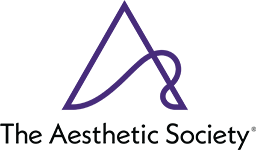
Fellow of the American Academy of Facial Plastic and Reconstructive Surgery (AAFPRS) or a similar organization such as the American Society of Plastic Surgeons (ASPS).

Official member of the International Society of Plastic and Aesthetic Surgeons
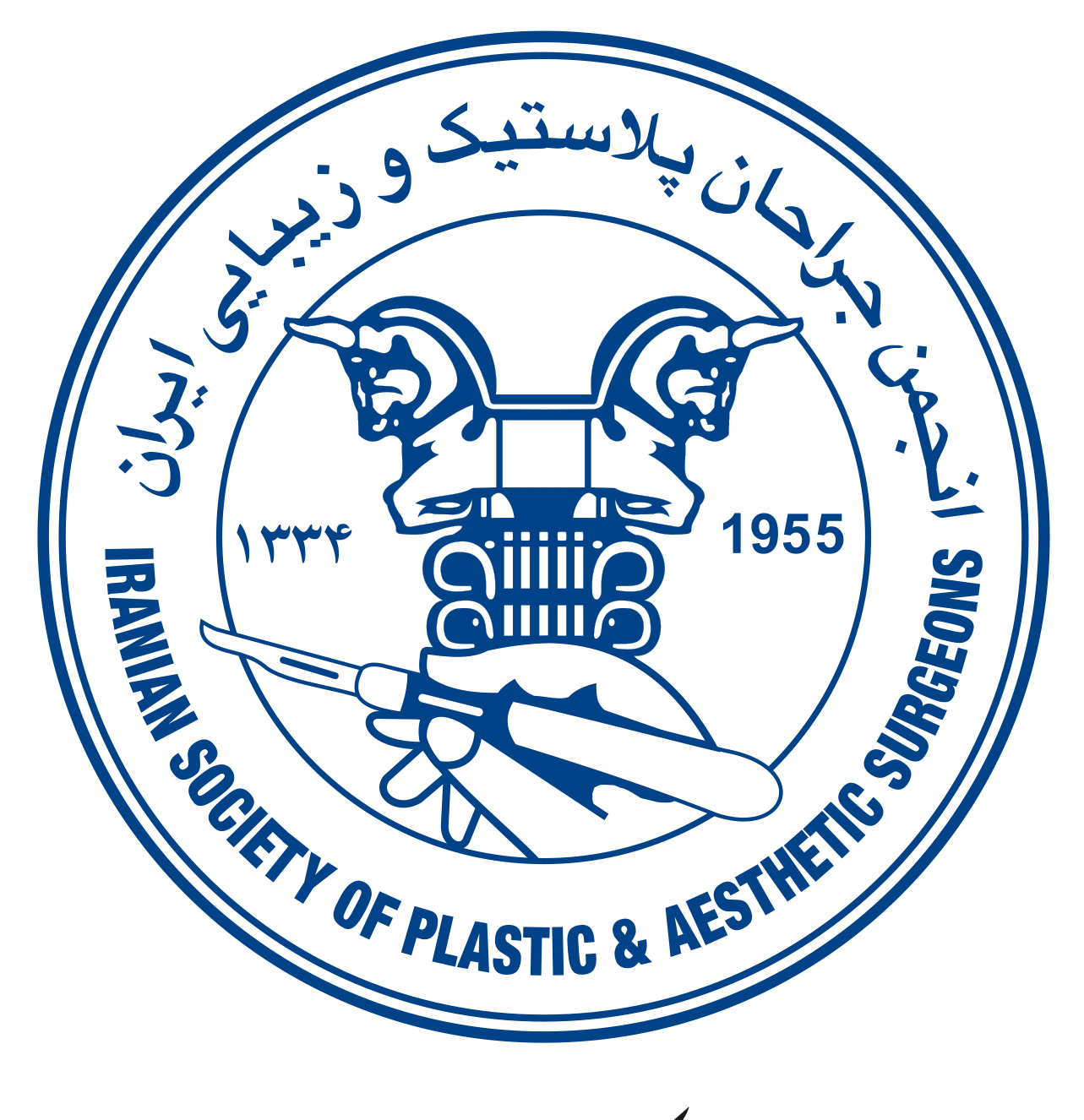
Official member of the Iranian Association of Plastic and Reconstructive Surgeons
FAQs
What tests are necessary before lipo-abdominoplasty surgery?
Complete blood tests, blood coagulation tests, metabolic tests, blood group typing, urine analysis, ECG, and possibly chest radiography will be performed to ensure your body’s readiness.
What is the recovery period like for lipo-abdominoplasty surgery, and how long does it take?
The recovery period includes pain, swelling, bruising, and limited activity. Typically about 6 weeks.
What are the serious complications of lipo abdominoplasty surgery, and how common are they?
Serious complications include bleeding, infection, hematoma, wound healing problems, pulmonary embolism, and anesthesia complications. Their occurrence is not definite and is reduced by choosing an experienced surgeon.
Does a lipoabdominoplasty procedure affect future pregnancies and C-sections?
Abdominoplasty may limit abdominal distension in pregnancy and affect recovery after C-section. Different types of weight loss surgeries are more suitable alternatives for future pregnancies.
What care is needed after lipoabdominoplasty surgery for faster recovery?
Using a special compression garment, caring for drains (if present), getting sufficient rest, having regular follow-ups with the doctor, and following medical instructions are essential for faster recovery.
Are the results of lipoabdominoplasty permanent, or is there a possibility of fat returning?
The results are permanent if weight remains stable and a healthy lifestyle is maintained. With weight gain, there is a possibility of fat returning in other areas.
